Happy Birthday Governor Pardee!
Republican George Cooper Pardee – born July 25, 1857 in San Francisco –probably couldn’t be elected governor today.
At least not as a Republican.
The political progenitor of the progressive agenda that bloomed under his successor Hiram Johnson, Pardee was a Republican in the Teddy Roosevelt mold.
His “liberalism” and willingness to increase taxes would almost certainly doom any chances of his nomination in 2012’s Republican party.
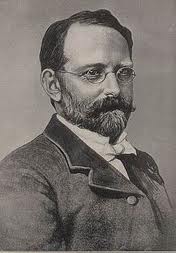 Pardee’s political philosophy led to suggestions of his being Roosevelt’s running mate in 1904 – even though the state’s 1.5 million inhabitants made California the 21st most populous of the 45 states.
Pardee’s political philosophy led to suggestions of his being Roosevelt’s running mate in 1904 – even though the state’s 1.5 million inhabitants made California the 21st most populous of the 45 states.
Pardee’s answer to the vice-presidency was “no” but he and Roosevelt remained political allies.
Denied a nomination for a second term by Southern Pacific Railroad and San Francisco political boss Abe Ruef, Pardee became a co-founder of the state Progressive “Bull Moose” Party, whose presidential candidate in 1912 was Roosevelt.
Bearded and bespectacled, Pardee favored frock coats, white ties and slouch hats. He was reserved and cautious – some historians say overly so – although his swiftness in responding to the 1906 San Francisco earthquake and its fiery aftermath were almost universally praised.
“He projected a philosophic reflectiveness in both conversation and correspondence,” write H. Brett Melendy and Benjamin Gilbert in The Governors of California.
Pardee is the only chief executive in the state’s 162-year history that is also a physician.
His medical training helped Pardee swiftly stamp out a bubonic plague outbreak in San Francisco whose existence was steadfastly denied for nearly four years by his GOP predecessor, Henry Gage.
During his medical studies in Leipzig Germany, Pardee was impressed by the country’s conservation efforts and, as governor, created a California Board of Forestry, which evolved into the Department of Forestry and Fire Protection, now known as CalFire.
“What will most promote the greatness of our state is protecting our natural resources from needless destruction or waste,” Pardee said in his January 6, 1903 inaugural speech. “And of all our resources there are none which stand more in need of safeguarding than our streams and forests.”
California’s 21st governor – and first native-born since statehood — also advocated for creation of a state agriculture-oriented university and, in 1906, Pardee selected a site 15 miles south of the Capitol then known as Davisville.
The biggest test of Pardee’s four-year governorship came after April 18, 1906 when an earthquake of at least 7.7 magnitude, followed by devastating fires, laid waste to San Francisco.
The front page of a joint issue of the San Francisco Call, Chronicle and Examiner from April 19 says:
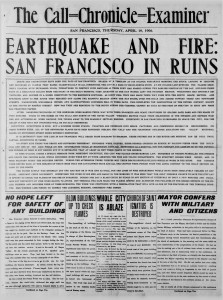 “Death and destruction have been the fate of San Francisco. Shaken by a temblor at 5:13 o’clock yesterday morning, the shock lasting 48 seconds, and scourged by flames that raged diametrically in all directions, the city is a mass of smoldering ruins.”
“Death and destruction have been the fate of San Francisco. Shaken by a temblor at 5:13 o’clock yesterday morning, the shock lasting 48 seconds, and scourged by flames that raged diametrically in all directions, the city is a mass of smoldering ruins.”
The Palace Hotel. The Fairmont. The St. Francis. Burned to the ground. As was the Chronicle, the Call and the Emporium department store. Nob Hill mansions of the Stanford, Hopkins, Huntington and Crocker families were reduced to scorched shells.
As many as 3,000 persons died. Some 8,000 were injured. Out of a population of 400,000, 225,000 were left homeless.
Three quarters of San Francisco was “laid low,” to use Pardee’s phrase.
Pardee initially estimated $300 million in taxable property was wiped out by the disaster. Subsequent estimates were higher.
Nor was San Francisco the only damaged city. The Napa and Sonoma Valleys were hit even harder. Workers reported grape vines and arbors rising and falling as though waves roiled beneath them. The city of Santa Rosa was almost completed destroyed.
“Hear rumors of great disaster through an earthquake in San Francisco but know nothing of the real facts. Call upon me for any assistance I can render,” telegrammed President Roosevelt five hours after the quake.
Pardee replied from Sacramento:
“Owing interruption of telegraph communications extent of disaster in San Francisco not well known here but no doubt calamity very serious. People of California appreciate your prompt inquiry and offer of assistance. State troops doing patrol duty and if federal assistance is needed will call upon you.”
Pardee, the first governor to seek and receive federal disaster aid, swiftly mobilized the National Guard, ordering them to shoot looters on sight.
Within the day, Pardee moved his office to his hometown of Oakland, taking personal charge of the state’s response to the disaster.
He remained there for six weeks.
“On hearing of the San Francisco disaster, Pardee immediately wired Mayor (Eugene) Schmitz of San Francisco pledging all possible state aid to the stricken city. By noon, he had issued orders dispatching units of the California National Guard to San Francisco and Oakland. Later that afternoon, he bid hasty farewell to his family and took the train for San Francisco,” writes Edward Staniford in his 1955 doctoral dissertation, Governor in the Middle: The Administration of George C. Pardee.
“He established headquarters in the Oakland City Hall (which) for the following six weeks … was the unofficial seat of the state government. The multifarious details of relief and reconstruction were so enormous that Pardee was unable to leave City Hall for days at a time.”
The governor established a system of messengers between Oakland and San Francisco and declared 41 days of successive bank holidays until safes and vaults could be pulled from the rubble. He took charge of sanitary regulations in the city to avoid the spread of typhoid.
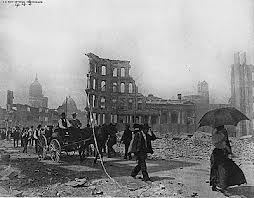 “For God’s Sake, send food,” Pardee telegraphed Los Angeles officials.
“For God’s Sake, send food,” Pardee telegraphed Los Angeles officials.
All told, the governor coordinated the distribution of more than $4 million in food and supplies as well as $1 million in cash assistance.
He also accepted the gift of thousands of pairs of shoes from the New England Shoe Association whose secretary, George Houghton, asked if such a contribution would be “timely and acceptable.”
Replied Pardee:
“It will be necessary to supply footwear to many poor people whose shoes were destroyed in walking over cinders in the streets. Therefore, your proposed gift would be acceptable. Thanks.”
Pardee pushed the state’s congressional delegation to win repayment of $5.6 million in federal debts to the state – some dating back to the Civil War. The money was subsequently used for earthquake relief.
Four days after the earthquake, Pardee could tell an Oakland Tribune reporter:
“The nation and the world is taking a great interest in our welfare and is showing material and financial aid…. The work of rebuilding San Francisco has commenced and I expect to see the great metropolis replaced on a much grander scale than ever before.”
Wrote Philip Fradkin in his 2005 book, The Great Earthquake and Firestorms of 1906: How San Francisco Nearly Destroyed Itself:
“Pardee was the great coordinator, acting as the liaison between those on the torn streets of San Francisco … and the outside world from his headquarters in the Oakland mayor’s office. From that mainland city, Pardee was in telegraphic contact with the rest of the country and the world. The governor guided the flow of money, goods and materials into the stricken city.
“Pardee lacked a glamorous frontline role and he was criticized for not dashing about the flame-licked streets. With a large staff imported from Sacramento, the governor was the expediter of paper; in every great disaster there needs to be at least one such competent bureaucrat.”
The day before the earthquake, Pardee had been making notary public appointments and regulating the control of agricultural pests, Fradkin notes.
When Pardee returned to Sacramento, his daughters were surprised to see his beard streaked with gray.
Waiting until the situation stabilized in San Francisco, Pardee did not call the Legislature into special session until June 2.
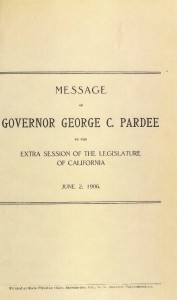 “Gentlemen of the Legislature, upon you devolves the solemn and necessary duty of giving such aid and comfort to those of our people who have suffered so heavily in the great disaster as reasonably lie in your power. That that aid and comfort should be quickly given goes without saying; for the needs are great and pressing,” Pardee told lawmakers in calling the special session.
“Gentlemen of the Legislature, upon you devolves the solemn and necessary duty of giving such aid and comfort to those of our people who have suffered so heavily in the great disaster as reasonably lie in your power. That that aid and comfort should be quickly given goes without saying; for the needs are great and pressing,” Pardee told lawmakers in calling the special session.
“In common with the people of the state, I wish you all success in your labors of the coming days of your session and hope that harmony may mark all your deliberations to the end that your labors may be quickly performed and brought to a speedy and successful end.”
By the end of 10 days, lawmakers approved 30 of the 34 measures proposed by Pardee.
The GOP governor also thanked the US Army and the National Guard for their efforts but neglected the US Navy – an oversight he rectified on June 18 in a letter to Admiral C.F. Goodrich, commander of the Pacific Squadron:
“No one could appreciate more than myself the services and aid rendered to us by the officers and men under your command. And I, therefore, regret, more than I can express, the blunder that gave that appreciation no official utterance. In consonance therewith and as a tardy reparation therefor, I venture, even at this late date, to tender you and the officers and men under your command my official and personal thanks for the very efficient and very great aid you and they rendered us in our hour of greatest need and to also express my personal and official apologies for the inexcusable oversight which kept them from appearing in my message to the Legislature.”
Early Years
Although Pardee was born in San Francisco, his family moved from their fashionable Rincon Hill home to Chicago where his father, Enoch, earned his medical degree in 1868.
Previously, Pardee’s father had successfully mined gold near Yuba City in the 1850s. He was later elected to the California Assembly and state Senate.
Pardee, an only child, was fond of recounting how his father took him by train to Washington D.C. in 1862 to meet President Lincoln, upon whose lap the future governor sat.
The family returned to the Bay Area from Chicago relocating in Oakland in part to improve the failing health of Pardee’s mother, Mary. She died in 1870. Pardee’s father built the Pardee Home, which still stands near Oakland’s City Hall.
Pardee graduated from Oakland High School in 1875 – a year before his father was elected Oakland’s mayor. Pardee earned a degree in philosophy from the University of California in 1879.
Like his father, Pardee became an eye, nose and ear specialist. He received his medical degree at the University of Leipzig in 1885 and then joined his father’s practice.
While in Germany Pardee wrote a monthly column for the San Francisco Chronicle under the pseudonym Amos Koeg, poking fun at the militarism and rigidity of life in Prussia.
Returning home, Pardee married his high school sweetheart, Helen Penniman.
They had four daughters: Florence, Caroline, Madeline and Helen.
Florence was killed in a 1910 car crash in Marin. Caroline died during the Spanish Flu epidemic in 1920. The surviving daughters lived in the Pardee Home until Helen’s death in 1981.
The Pardees were the first family to live in the Governor’s Mansion at 16th and H Streets in Sacramento. The mansion, built in 1877 and sold to the state for $32,588.53 in 1903, still contains the Pardees’ 1902 Steinway.
They added an office with an outside entrance so visitors wouldn’t disturb the family.
Pardee, who continued to practice medicine after becoming governor, kept his black bag on a hallway table.
Helen Pardee’s sister, Marietta “Etta” Penniman, also lived at the mansion. She supervised the girls. Delia Malloy was the Irish housekeeper and Leona the cook.
Among the duties of Olaf the gardener was caring for the family horse, Lady Jane, and the carriages.
According to a handout from the Governor’s Mansion Historic State Park, the Pardee girls had two dogs, a cat, a parrot, a lamb and a chipmunk that hid in the draperies. They enjoyed roller-skating on the newly cemented floor of the mansion’s basement.
 Mrs. Pardee was a prodigious collector of just about anything. Canes, walking sticks, scrimshaw from Alaska, tobacco pipes from the Philippines, candlesticks from India, altarpieces from China and rosaries from Mexico are a few of the items listed on the Pardee Home webpage.
Mrs. Pardee was a prodigious collector of just about anything. Canes, walking sticks, scrimshaw from Alaska, tobacco pipes from the Philippines, candlesticks from India, altarpieces from China and rosaries from Mexico are a few of the items listed on the Pardee Home webpage.
She attended the California State Normal School, now San Jose State, and taught for 10 years at the Grove Street School in Oakland.
An artist and avid entertainer, Helen Pardee was also a member of the “Merry Tramps of Oakland,” a club that camped and hiked throughout Northern California. Pardee was known as “Helen Blazes” partly because of her red hair.
Pardee and her friends created a crazy quilt on display in the master bedroom of the Pardee Home. One tan scrap is embroidered with “Lincoln,” supposedly from a dress of Mary Todd Lincoln’s.
Black Death and the Governorship
In 1889, Pardee was appointed to the Oakland Board of Health. He was elected to the city council in 1891, serving from 1893 to 1895 as mayor.
He made a run for governor in 1898 but lost to Henry Gage, the chosen candidate of the Southern Pacific Railroad.
While mayor, Pardee fought to make the Port of Oakland public by wresting its ownership from Southern Pacific, creating a powerful and career-long political enemy.
Unlike Gage, Pardee did not kowtow to the railroad but he didn’t criticize them in public either, attempting, in his words, to be “the man in the middle.’
The state GOP was divided in 1902 between those in Southern Pacific’s thrall and those who wanted to end the railroad’s dominance over their party.
While Pardee was a member of the party’s anti-Southern Pacific wing, he was “more willing than (other) members of his faction to compromise,” Staniford says.
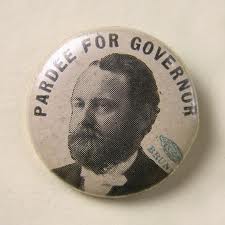 Although the railroad continued to support Gage for re-election in 1902, his reputation was tarnished by a long-running outbreak of bubonic plague in San Francisco.
Although the railroad continued to support Gage for re-election in 1902, his reputation was tarnished by a long-running outbreak of bubonic plague in San Francisco.
Ultimately, the railroad sided with Pardee as a compromise candidate, leaving him truly the man in the middle.
Pardee had to convince laborers he did not call for the use of fire hoses and pick handles to break up an 1894 strike in Oakland while, at the same time, satisfy progressives he was not in Southern Pacific’s pocket.
“Progress, Prosperity and Pardee” was the banner displayed at his campaign headquarters at The Palace Hotel in San Francisco.
The day before the election, Pardee spoke to a large group of workers — all Southern Pacific employees — in the Oakland rail yards.
Pardee bested his Democratic opponent, Franklin Lane – an ardent critic of Southern Pacific — by just 2,539 votes.
His victory was thrown into doubt when 5,000 ballots in Los Angeles and Oakland were found to have been disqualified. It fell to the state supreme court to declare Pardee the winner.
Pardee inherited a long-running — and deadly — dilemma from his predecessor.
Fearing quarantine on California products and an economic backlash, Gage steadfastly denied the presence of any plague in San Francisco. He did so for nearly four years.
“There has been no epidemic in Chinatown. The municipal records show the proportion of deaths in Chinatown has been no greater than that of any other portion of San Francisco since the date of the discovery of the alleged plague in Chinatown,” Gage telegraphed the US Secretary of State.
After several years, the denials – in the face of determinations by federal health officials that indeed there was plague – led to moves by Colorado, Texas and Louisiana to quarantine California products. Mexico blamed a plague in Mazatlan on rats in vegetable crates from San Francisoc. Ecuador banned all vessels from California. 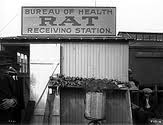
During the 1902 campaign, Pardee was silent on the plague but sent private signals to federal doctors that he would support wiping it out if elected.
Once elected, he was still reluctant to trumpet the plague’s presence.
“An open acknowledgement of the plague would … anger his supporters and undermine his administration. He preferred to lend his support behind the scenes,” writes Marilyn Chase in The Barbary Plague: The Black Death in Victorian San Francisco.
But in February 1903, one month after taking office, Pardee signed the order that led to the eradication of the plague. State and federal health officials brought it under control by 1904 – after nearly 200 deaths.
Other Actions
Pardee kept the door to the governor’s office open and its atmosphere informal. It was a continuation of his campaign practice of sitting in an open room and chatting with everyopne who entered.
“No secrecy is practiced in the governor’s office now and all who go there on public business must be willing to let others hear their conversation with Governor Pardee, the Sacramento Bee wrote in 1903.
Pardee’s staff consisted of four men — twp secretaries, astenographer and a messenger.
Pardee’s closest political confidante, A. B. Nye, the editor of the Oakland Inquirer, was his personal secretary.
Pardee’s messenger was Jacob Soares, born in Jamaica in 1850. He helped get out the black vote for Gage in 1898 who first appointed him messenger, a job Soares held through the administration of James Gillett, Pardee’s successor. Soares served as valet to Roosevelt when he visited the Pardees at the Governor’s Mansion in 1903 and did preparatory legal work for the special legislative session called after the 1906 earthquake.
When Pardee became governor, Berkeley was the only University of California campus. So if any agricultural studies were to be conducted by UC, that’s where they took place. That’s one reason more than a century later there’s still a major agricultural presence at Berkeley.
A growing movement, buoyed by Sacramento Judge Peter Shields called for creation of a “university farm.” Shields wrote the legislation ultimately signed by Pardee that led to creation of UC Davis.
Pardee vetoed the first university farm bill sent to him in 1903, saying it was too vague. The bill Pardee signed on March 18, 1905 was anything but vague.
 It specified the university farm must be located where there is existing irrigation, superior soil and climate as well as water and land rights.
It specified the university farm must be located where there is existing irrigation, superior soil and climate as well as water and land rights.
A commission was created to select a site and $150,000 appropriated to buy the land.
Of the options presented to him, Pardee chose the town then known as Davisville. The main library at UC Davis is named for Shields.
The first residential class in January 1909 numbered 18 men. The only dormitory — the still-standing North Hall — wasn’t built to accomodate women.
In his inaugural speech, Pardee called for construction of enough classrooms to allow every child at least six years of education. And to ensure greater attendance, he urged curbing of child labor.
Pardee broke with Roosevelt over the state’s backlash against Japanese immigration. In 1906, a year after Roosevelt won the Nobel Peace Prize for brokering peace between Japan and Russia, San Francisco’s Board of Education passed an ordinance requiring all Japanese children to attend the city’s Chinese school. Previously, children of Japanese ancestry attended various public schools — with the permission of the white parents.
Japan was outraged and fears of war were rekindled. Roosevelt sharply criticized the action calling a “wicked absurdity” in a December 4, 1906 speech to Congress.
“It is safe to say that the President, when he penned that portion of his annual message upon the opening of Congress in which he refers to the treatment of the Japanese in the San Francisco schools, was not aware of the conditions on this coast, especially in California,” Pardee said in his second biennial message to the Legislature.
“Neither the Japanese nor the Chinese appear to be capable of absorption and assimilation into the mass of our people. Neither race has, apparently, any desire to renounce allegiance to its mother country and become, in the true sense of the word, citizens of the United States.”
Pardee signed a joint legislative resolution urging the federal government to protect the “Pacific Coast from the heavy influx of Japanese.”
What’s known as the “Gentleman’s Agreement” was subsequently struck between the US and Japan. The children returned to public schools and Japan reduced the number of immigrants to America.
Like many of his predecessors and successors, Pardee struggled with the state’s finances.
When he took office, Pardee said the general fund would be exhausted requiring borrowing from special funds. However, taxes were boosted and by June 1904 the general fund had a balance of $2 million and all borrowing had been repaid. When he left office, Pardee reported with some satisfaction a $1 million surplus — despite the earthquake and fire.
Pardee presented lawmakers with a detailed budget. In part, his goal was to have lawmakers not approve spending piecemeal, which spawned the addition of pork barrel projects. With passage of an omnibus budget act — some $5.4 billion in 1903 — Pardee would be free to veto subsequent individual pork barrel measures.
 The plan backfired to some extent. The move caused lawmakers to pass even more special interest legislation knowing the GOP governor would take the heat for vetoing them, which he was happy to do.
The plan backfired to some extent. The move caused lawmakers to pass even more special interest legislation knowing the GOP governor would take the heat for vetoing them, which he was happy to do.
California’s 21st governor also made the Golden Poppy the state flower.
Despite his widely praised performance in the earthquake’s aftermath, Southern Pacific controlled Republicans denied Pardee the party’s nomination for re-election, fueling calls for reform of the nomination process by the party’s progressives.
Not surprisingly, Pardee devotes several pages of his second biennial address to the need to switch to a direct primary to select candidates.
Pardee also notes that “the material condition of the state, as a whole, was never better than at present nor perhaps ever before so good. This favorable situation of our state appears truly remarkable when it is remembered that the disaster of April 18, 1906 resulted in a destruction of property values of at least half a billion dollars and a temporary suspension of all business in the commercial metropolis of the Pacific Coast.”
Pardee also called for an increase in pay for state officeholders saying that despite living rent free in the Governor’s Mansion and receiving $2,5000 for expenses, his salary of $6,000 was not enough to live on.
Life After Sacramento
Pardee returned to his medical practice but must have struggled to find time to be a doctor.
He co-founded the state Progressive party at a meeting at Oakland’s Metropole Hotel near his home.
In 1911 Gov. Hiram Johnson appointed him chair of the California Conservation Commission whose charge was to protect forest and water resources. Eight years later, Pardee was named the head of the state Board of Forestry he had created, resigning in 1923 to protest cuts made by GOP Gov. Friend Richardson.
When Gov. C. C. Young, a moderate Republican in Pardee’s mold, took office in 1928, the former governor returned to the board.
From 1924 until a few months before his death in 1941 at 84, Pardee helped administer the East Bay Municipal Utility District, which he helped create.
The Pardee Dam and reservoir on the Mokelumne River are named for him.
The Governor’s Office in the “old” wing of the Capitol is designed to look as it did during Pardee’s administration.
-30-
Filed under: California History
Capitol Cliches Conversational Currency Great Moments in Capitol History News Budget and Economy California History Demographics Fundraising Governor Legislature/Legislation Politics State Agencies
Opinionation Overheard Today's Latin Lesson
Restaurant Raconteur Spotlight Trip to Tokyo Venting Warren Buffett Welcome Words That Aren't Heard in Committee Enough


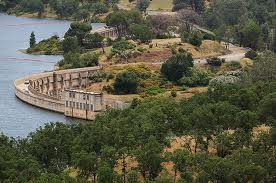
Let’s hear it for those progressives…..may they rise again!
Comment by Linda Muir — 7.25.2012 @ 8:19 pm
Thanks for running this. Interesting and well-written.
Comment by JoAnn Anglin — 7.25.2012 @ 8:32 pm
Loads of great information. I’m a docent at the Pardee Home Museum in Oakland. I’ll pass this article on to my fellow docents.
Comment by Dennis Evanosky — 7.31.2012 @ 8:06 pm
I was watching Ken Burns special on national parks this evening. They metnioned the trip Teddy Rosevelt and John Muir took to Yosemite in 1903. They mentioned the CA Gov. at the time was with them. I thought it must’ve been Gov. Pardee. so I did little Google search, which led me tho your site. I met The Gov’s daughters Helen and Madeline when I was maybe 10, or 12 years old in the late 60’s at their house in Oakland. They were very old at the time, but I rememeber them showing my family the many artifacts he had collected. My great Grandmother on my Grandmothers side was a Pardee from Susanville, a second cousin, I believe. My grandmother knew Helen and Madeline from visits she made to their Oakland house as a child.
Thanks for the history lesson!
Evan Pace
Comment by Evan Pace — 1.23.2013 @ 10:58 pm